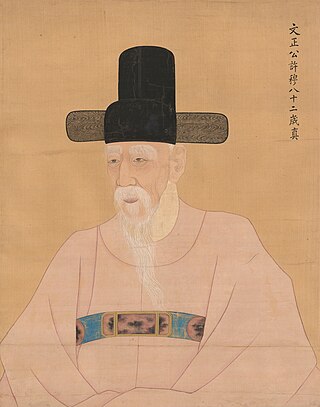This article needs additional citations for verification .(August 2023) |
| Korean name | |
 Book describing Northerners and Southerners (estimated 19th century) | |
| Korean name | |
|---|---|
| Hangul | 붕당 |
| Hanja | |
| Revised Romanization | Bungdang |
| McCune–Reischauer | Pungtang |
The Bungdang (Korean : 붕당; Hanja : 朋黨) refers to political factionalism that was characteristic of the middle and late Joseon dynasty in Korea. Throughout the dynasty,various regional and ideological factions struggled for dominance in the political system.
Contents
- Factions of Sarim
- Philosophical lineage
- Division of Sarim
- Political leaders
- Portrayal in media
- See also
- References
- Bibliography
During the 15th and 16th centuries,national politics were dominated by tensions between the Hungu faction in the capital and the Sarim faction based in Yeongnam,which culminated in a series of four literati purges (sahwa) between 1498 and 1545 in which the Sarim were persecuted by the Hungu. [1] Following these setbacks,the Sarim faction withdrew to rural provinces where they maintained their power base and ideological continuity through seowon (private institutions which combined the functions of a Confucian shrine and a preparatory academy for the civil service examinations) and hyangyak (a system of social contract that gave local autonomy to villages). Village seowon often reflected the factional alignment of the local elite. Eventually,the Hungu faction declined without an ideological successor while the Sarim faction emerged as the dominant faction during the reign of Seonjo.
In the late 16th century,a nationwide split occurred within the Sarim between the Western faction (Seoin) and the Eastern faction (Dongin),composed mainly of the younger generation. Political divisions intensified even further as in turn the Easterners split between the hard-line Northern faction (Bukin) and the moderate Southern faction (Namin), [2] and the Westerners split between the Old Learning (Noron) and the Young Learning (Soron). These four factions are sometimes known as sasaek ("four colors"),as they were represented by red,white,black,and green. [3] The Northerners later split into the Greater Northern and Lesser Northern factions,with the Great Northerners further splitting into three other factions. The faction names often derived from the relative location of their leader's house.
These divisions grew out of allegiance to different philosophical schools and regional differences. The Easterners were largely based in Yeongnam;as for its subfactions,the Southerners were mainly followers of Yi Hwang,while the Northerners coalesced around the school of Jo Sik. The Westerners were based in Gyeonggi and Chungcheong,and were largely followers of Yi I;followers of Seong Hon formed the Soron,while Song Si-yeol's followers became the Noron. These divisions were often further driven by questions concerning royal succession or appropriate royal conduct. For example,the split between the Northerners and Southerners was driven by debate over the proper successor to Seonjo. The Northerners supported Gwanghaegun;accordingly,they flourished under his reign (1608–1623),but were swept from power by the Westerners after the succession of Injo.
Under the reigns of Yeongjo and Jeongjo in the 18th century,a strict policy of equality was pursued,with no faction favoured over another. [4] However,during Jeongjo's reign,strife re-emerged as the ruling Noron split further between the Byeokpa and Sipa,two groups which cut across the earlier factions and differed in their attitudes concerning Yeongjo's execution of his son,Crown Prince Sado,who was also Jeongjo's biological father. Eventually,the Byeokpa faction was eliminated by the Sipa in 1804. This marked the end of the Bungdang. Factions never again formed around philosophical and political beliefs. [1] After the elimination of the Byeokpa,Joseon politics in the 19th century shifted significantly,and the dynasty began to crumble as in-law families,rather than scholarly factions,came to dominate the throne. For most of the 19th century,the Andong Kim clan controlled the government;however,there was a brief interlude in which control shifted to the Pungyang Jo clan.
During the reign of Gojong,real power initially belonged to his father,the Grand Internal Prince Heungseon,who on one hand sought to reform corrupt state institutions but on the other hand pursued a policy of isolationism,opposing the opening of the country to Western and Japanese influences. From the 1870s onwards,Queen Min (known posthumously as Empress Myeongseong) became more dominant and pursued a policy of cautious modernisation and opening up. Her dominance was opposed by reactionaries and progressives alike. In particular,the progressive Gaehwa Party sought to modernise the country along Western and Japanese lines. These factional struggles led to the Imo Incident and Gapsin Coup,as well as increased foreign interference in Korean affairs.








